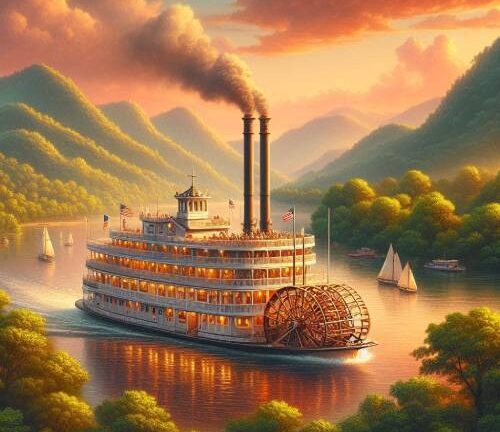The History of Steamboats: Evolution and Modern Applications
Introduction
Steamboats revolutionized transportation and commerce by utilizing steam power to navigate waterways. This essay explores the origins of steamboats, their evolution over time, the pioneers behind their development, and their modern applications.
When were Steamboats Invented
The idea of steam propulsion for boats dates back to ancient times, but practical application began in the late 18th century. The first commercially successful steamboat was built by Claude de Jouffroy in France in 1783. It used a steam engine to power paddle wheels. However, it was Robert Fulton, an American inventor and engineer, who became synonymous with the steamboat’s success.
In 1807, Fulton’s steamboat, the Clermont, made its maiden voyage up the Hudson River from New York City to Albany, demonstrating the viability of steam power for inland navigation. This marked a pivotal moment in transportation history, as steamboats rapidly spread across America and Europe, transforming river transportation and trade.
Evolution of Steamboats
Early steamboats faced challenges such as inefficient engines and limited range. However, technological advancements rapidly improved their design and capabilities:
- 1830s-1850s: The introduction of compound engines and improved hull designs increased efficiency and speed.
- Late 19th Century: The development of screw propellers replaced paddle wheels, enhancing maneuverability and efficiency.
- 20th Century: Steam turbine engines and diesel engines replaced steam engines, further improving performance and reliability.
Impact and Uses Over Time
- Transportation and Commerce: Steamboats opened up previously inaccessible inland waterways for trade, agriculture, and passenger transport. They played a crucial role in the economic development of regions along major rivers.
- Military and Warfare: Steam-powered warships, such as ironclads, revolutionized naval warfare during the American Civil War and other conflicts, showcasing steamboats’ strategic importance.
- Cultural and Social Impact: Steamboats facilitated migration and cultural exchange, connecting communities and shaping regional identities.
Modern Applications
While steamboats no longer dominate transportation as they once did, their legacy persists in various forms:
- Tourism: Historic steamboats, like the Delta Queen or the SS Sicamous, now serve as tourist attractions, offering nostalgic river cruises.
- Research and Exploration: Modern research vessels and ferries utilize advanced steam turbine or diesel-electric propulsion systems from early steamboat technology.
- Industrial Use: Steam turbines power large ships and naval vessels, providing reliable propulsion for ocean-going vessels.
Conclusion
The history of steamboats is a testament to human ingenuity and technological progress. From their humble beginnings as experimental vessels to their widespread adoption and modern adaptations, steamboats have left an indelible mark on transportation, commerce, and culture. While modern ships and boats have largely moved on to other propulsion methods, the legacy of steamboats lives on in our understanding of how steam power can transform water transport.
In conclusion, steamboats represent a pivotal chapter in the history of maritime technology, demonstrating the power of innovation and adaptation in shaping the world we live in today.


